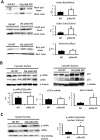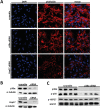p38α regulates actin cytoskeleton and cytokinesis in hepatocytes during development and aging
- PMID: 28166285
- PMCID: PMC5293263
- DOI: 10.1371/journal.pone.0171738
p38α regulates actin cytoskeleton and cytokinesis in hepatocytes during development and aging
Abstract
Background: Hepatocyte poliploidization is an age-dependent process, being cytokinesis failure the main mechanism of polyploid hepatocyte formation. Our aim was to study the role of p38α MAPK in the regulation of actin cytoskeleton and cytokinesis in hepatocytes during development and aging.
Methods: Wild type and p38α liver-specific knock out mice at different ages (after weaning, adults and old) were used.
Results: We show that p38α MAPK deficiency induces actin disassembly upon aging and also cytokinesis failure leading to enhanced binucleation. Although the steady state levels of cyclin D1 in wild type and p38α knock out old livers remained unaffected, cyclin B1- a marker for G2/M transition- was significantly overexpressed in p38α knock out mice. Our findings suggest that hepatocytes do enter into S phase but they do not complete cell division upon p38α deficiency leading to cytokinesis failure and binucleation. Moreover, old liver-specific p38α MAPK knock out mice exhibited reduced F-actin polymerization and a dramatic loss of actin cytoskeleton. This was associated with abnormal hyperactivation of RhoA and Cdc42 GTPases. Long-term p38α deficiency drives to inactivation of HSP27, which seems to account for the impairment in actin cytoskeleton as Hsp27-silencing decreased the number and length of actin filaments in isolated hepatocytes.
Conclusions: p38α MAPK is essential for actin dynamics with age in hepatocytes.
Conflict of interest statement
The authors have declared that no competing interests exist.
Figures








Similar articles
-
p38α deficiency restrains liver regeneration after partial hepatectomy triggering oxidative stress and liver injury.Sci Rep. 2019 Mar 7;9(1):3775. doi: 10.1038/s41598-019-39428-3. Sci Rep. 2019. PMID: 30846722 Free PMC article.
-
p38α deficiency and oxidative stress cause cytokinesis failure in hepatocytes.Free Radic Biol Med. 2014 Oct;75 Suppl 1:S19. doi: 10.1016/j.freeradbiomed.2014.10.633. Epub 2014 Dec 10. Free Radic Biol Med. 2014. PMID: 26461300
-
Liver-specific p38α deficiency causes reduced cell growth and cytokinesis failure during chronic biliary cirrhosis in mice.Hepatology. 2013 May;57(5):1950-61. doi: 10.1002/hep.26174. Epub 2013 Jan 25. Hepatology. 2013. PMID: 23354775
-
Regulation of cytokinesis and its clinical significance.Crit Rev Clin Lab Sci. 2015;52(4):159-67. doi: 10.3109/10408363.2015.1012191. Epub 2015 Jun 24. Crit Rev Clin Lab Sci. 2015. PMID: 26104038 Review.
-
The mitotic functions of integrin-linked kinase.Cancer Metastasis Rev. 2009 Jun;28(1-2):99-111. doi: 10.1007/s10555-008-9177-0. Cancer Metastasis Rev. 2009. PMID: 19153670 Review.
Cited by
-
Cellular polyploidy in organ homeostasis and regeneration.Protein Cell. 2023 Aug 1;14(8):560-578. doi: 10.1093/procel/pwac064. Protein Cell. 2023. PMID: 37526344 Free PMC article.
-
Age-dependent regulation of antioxidant genes by p38α MAPK in the liver.Redox Biol. 2018 Jun;16:276-284. doi: 10.1016/j.redox.2018.02.017. Epub 2018 Feb 17. Redox Biol. 2018. PMID: 29567616 Free PMC article.
-
p38α deficiency restrains liver regeneration after partial hepatectomy triggering oxidative stress and liver injury.Sci Rep. 2019 Mar 7;9(1):3775. doi: 10.1038/s41598-019-39428-3. Sci Rep. 2019. PMID: 30846722 Free PMC article.
-
Defective recruitment of motor proteins to autophagic compartments contributes to autophagic failure in aging.Aging Cell. 2018 Aug;17(4):e12777. doi: 10.1111/acel.12777. Epub 2018 May 29. Aging Cell. 2018. PMID: 29845728 Free PMC article.
-
In-vitro study of monocytic THP-1 leukemia cell membrane elasticity with a single-cell microfluidic-assisted optical trapping system.Biomed Opt Express. 2020 Oct 1;11(10):6027-6037. doi: 10.1364/BOE.402526. eCollection 2020 Oct 1. Biomed Opt Express. 2020. PMID: 33150003 Free PMC article.
References
MeSH terms
Substances
LinkOut - more resources
Full Text Sources
Other Literature Sources
Molecular Biology Databases
Research Materials
Miscellaneous

